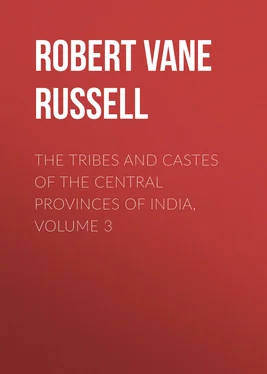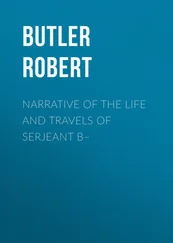Robert Vane Russell - The Tribes and Castes of the Central Provinces of India, Volume 3
Здесь есть возможность читать онлайн «Robert Vane Russell - The Tribes and Castes of the Central Provinces of India, Volume 3» — ознакомительный отрывок электронной книги совершенно бесплатно, а после прочтения отрывка купить полную версию. В некоторых случаях можно слушать аудио, скачать через торрент в формате fb2 и присутствует краткое содержание. Жанр: foreign_prose, История, foreign_edu, foreign_antique, на английском языке. Описание произведения, (предисловие) а так же отзывы посетителей доступны на портале библиотеки ЛибКат.
- Название:The Tribes and Castes of the Central Provinces of India, Volume 3
- Автор:
- Жанр:
- Год:неизвестен
- ISBN:нет данных
- Рейтинг книги:5 / 5. Голосов: 1
-
Избранное:Добавить в избранное
- Отзывы:
-
Ваша оценка:
- 100
- 1
- 2
- 3
- 4
- 5
The Tribes and Castes of the Central Provinces of India, Volume 3: краткое содержание, описание и аннотация
Предлагаем к чтению аннотацию, описание, краткое содержание или предисловие (зависит от того, что написал сам автор книги «The Tribes and Castes of the Central Provinces of India, Volume 3»). Если вы не нашли необходимую информацию о книге — напишите в комментариях, мы постараемся отыскать её.
The Tribes and Castes of the Central Provinces of India, Volume 3 — читать онлайн ознакомительный отрывок
Ниже представлен текст книги, разбитый по страницам. Система сохранения места последней прочитанной страницы, позволяет с удобством читать онлайн бесплатно книгу «The Tribes and Castes of the Central Provinces of India, Volume 3», без необходимости каждый раз заново искать на чём Вы остановились. Поставьте закладку, и сможете в любой момент перейти на страницу, на которой закончили чтение.
Интервал:
Закладка:
34. Mourning and offerings to the dead
Mourning is usually observed for three days. The mourners abstain from work and indulgence in luxuries, and the house is cleaned and washed. The Gonds often take food on the spot after the burial or burning of a corpse and they usually drink liquor. On the third day a feast is given. In Chhindwāra a bullock or cow is slaughtered on the death of a male or female Gond respectively. They tie it up by the horns to a tree so that its forelegs are in the air, and a man slashes it across the head once or twice until it dies. The head is buried under a platform outside the village in the name of the deceased. Sometimes the spirit of the dead man is supposed to enter into one of the persons present and inform the party how he died, whether from witchcraft or by natural causes. He also points out the place where the bullock’s or cow’s head is to be buried, and here they make a platform to his spirit with a memorial stone. Red lead is applied to the stone and the blood of a chicken poured over it, and the party then consume the bodies of the cow and chicken. In Mandla the mourners are shaved at the grave nine or ten days after the death by the brother-in-law or son-in-law of the deceased, and they cook and eat food there and drink liquor. Then they come home and put oil on the head of the heir and tie a piece of new cloth round his head. They give the dead man’s clothes and also a cow or bullock to the Pardhān priest, and offer a goat to the dead man, first feeding the animal with rice, and saying to the dead man’s spirit, ‘Your son- or brother-in-law has given you this.’ Sometimes the rule is that the priest should receive all the ornaments worn on the right side of a man or the left side of a woman, including those on the head, arm and leg. If they give him a cow or bullock, they will choose the one which goes last when the animals are let out to graze. Then they cook and eat it in the compound. They have no regular anniversary ceremonies, but on the new moon of Kunwār (September) they will throw some rice and pulse in front of the house and pour water on it in honour of the dead. The widow breaks her glass bangles when the funeral takes place, and if she is willing she may be married to the dead man’s younger brother on the expiry of the period of mourning.
35. Memorial stones to the dead
In Bastar, at some convenient time after the death, a stone is set up in memory of any dead person who was an adult, usually by the roadside. Families who have emigrated to other localities often return to their parent village for setting up these stones. The stones vary according to the importance of the deceased, those for prominent men being sometimes as much as eight feet high. In some places a small stone seat is made in front, and this is meant for the deceased to sit on, the memorial stone being his house. After being placed in position the stone is anointed with turmeric, curds, ghī and oil, and a cow or pig is offered to it. Afterwards irregular offerings of liquor and tobacco are made to the dead man at the stone by the family and also by strangers passing by. They believe that the memorial stones sometimes grow and increase in size, and if this happens they think that the dead man’s family will become extinct, as the stone and the family cannot continue to grow together. Elsewhere a long heap of stones is made in honour of a dead man, sometimes with a flat-topped post at the head. This is especially done for men who have died from epidemic disease or by an accident, and passers-by fling stones on the heap with the idea that the dead man’s spirit will thereby be kept down and prevented from returning to trouble the living. In connection with the custom of making a seat at the deceased’s tomb for his spirit to sit upon, Mr. A. K. Smith writes: “It is well known to every Gond that ghosts and devils cannot squat on the bare ground like human beings, and must be given something to sit on. The white man who requires a chair to sit on is thus plainly akin to the world of demons, so one of the few effective ways of getting Gonds to open their mouths and talk freely is to sit on the ground among them. Outside every Gond house is placed a rough bench for the accommodation of any devils that may be flitting about at night, so that they may not come indoors and trouble the inmates.”
36. House abandoned after a death
If one or two persons die in a house in one year, the family often leave it and make another house. On quitting the old house they knock a hole in the back wall to go out, so as to avoid going out by the front door. This is usually done when the deaths have been due to an epidemic, and it is presumably supposed that the dead men’s spirits will haunt the house and cause others to die, from spite at their own untimely end. If an epidemic visits a village, the Gonds will also frequently abandon it, and make a new village on another site.
37. Bringing back the soul
They believe that the spirits of ancestors are reincarnated in children or in animals. Sometimes they make a mark with soot or vermilion on the body of a dead man, and if some similar mark is subsequently found on any newborn child it is held that the dead man’s spirit has been reborn in it. In Bastar, on some selected day a short time after the death, they obtain two small baskets and set them out at night, placing a chicken under one and some flour of wheat or kutki under the other. The householder then says, “I do the work of those old men who died. O spirits, I offer a chicken to you to-day; be true and I will perform your funeral rites to-morrow.” On the next morning the basket placed over the flour is lifted up, and if a mark resembling a footprint of a man or any animal be found, they think that the deceased has become incarnate in a human being or in that animal. Subsequently they sacrifice a cow to the spirit as described. In other places on the fifth day after death they perform the ceremony of bringing back the soul. The relatives go to the riverside and call aloud the name of the dead person, and then enter the river, catch a fish or insect and, taking it home, place it among the sainted dead of the family, believing that the spirit of the dead person has in this manner been brought back to the house. The brother-in-law or son-in-law of the dead man will make a miniature grass hut in the compound and place the fish or insect inside it. He will then sacrifice a pig, killing it with a rice-husker, and with not more than three blows. The animal is eaten, and next morning he breaks down the hut and throws away the earthen pots from the house. They will spread some flour on the ground and in the morning bring a chicken up to it. If the animal eats the flour they say that the soul of the deceased has shown his wish to remain in the house, and he is enshrined there in the shape of a stone or copper coin. If it does not eat, then they say that the spirit will not remain in the house. They take the stone or coin outside the village, sacrifice a chicken to it and bury it under a heap of stones to prevent it from returning. Sometimes at the funeral ceremony one of the party is possessed by the spirit of the dead man, and a little white mark or a small caterpillar appears on his hand, and they say that it is the soul of the dead man come back. Then the caterpillar vanishes again, and they say that the dead man has been taken among the gods, and go home. Occasionally some mark may appear on the hand of the dead man’s son after a period of time, and he says that his father’s soul has come back, and gives another funeral feast. The good souls are quickly appeased and their veneration is confined to their descendants. But the bad ones excite a wider interest because their evil influences may be extended to others. And the same fear attaches to the spirits of persons who have died a violent or unnatural death. The soul of a man who has been eaten by a tiger must be specially propitiated, and ten or twelve days are occupied in bringing it back. To ascertain when this has been done a thread is tied to a beam and a copper ring is suspended from it, being secured by twisting the thread round it and not by a knot. A pot full of water is placed below the ring. Songs are then sung in propitiation and a watch is kept day and night. When the ring falls from the thread and drops into the water it is considered that the soul has come back. If the ring delays to fall they adjure the dead man to come back and ask where he has gone to and why he is tarrying. Animals are offered to the ring and their blood poured over it, and when it finally falls they rejoice greatly and say that the dead man has come back. The ancestors are represented by small pebbles kept in a basket in the kitchen, which is considered the holiest part of the house, or they may be pice copper coins (¼d.) tied up in a little bundle. They are daubed with vermilion and worshipped occasionally. A man who has been killed by a tiger or cobra may receive general veneration, with the object of appeasing his spirit, and become a village god. And the same honour may be accorded to any prominent man, such as the founder of a village.
Читать дальшеИнтервал:
Закладка:
Похожие книги на «The Tribes and Castes of the Central Provinces of India, Volume 3»
Представляем Вашему вниманию похожие книги на «The Tribes and Castes of the Central Provinces of India, Volume 3» списком для выбора. Мы отобрали схожую по названию и смыслу литературу в надежде предоставить читателям больше вариантов отыскать новые, интересные, ещё непрочитанные произведения.
Обсуждение, отзывы о книге «The Tribes and Castes of the Central Provinces of India, Volume 3» и просто собственные мнения читателей. Оставьте ваши комментарии, напишите, что Вы думаете о произведении, его смысле или главных героях. Укажите что конкретно понравилось, а что нет, и почему Вы так считаете.












